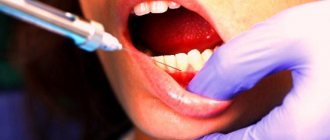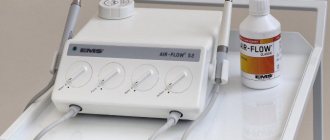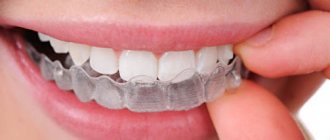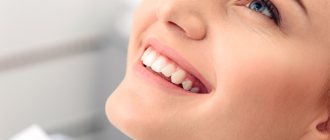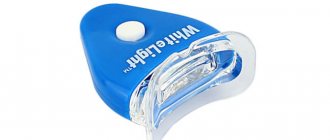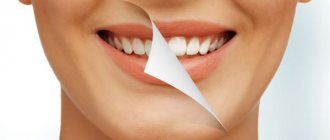The main composition of teeth whitening pastes
- Abrasives
- Preservatives (increase the life of the paste)
- Special additives (settle on the teeth and create a whitening effect)
- Foaming agents
- Minerals (fluorine, calcium, phosphorus, etc.)
- Chemical reagents (help dissolve plaque)
to use tooth whitening pastes after a professional whitening procedure. This way you can maintain the results and maintain your new smile color. Often such pastes are used for better cleaning of the dentition. As a rule, the effect is observed after a month, and sometimes even several weeks, but only if you brush your teeth with a whitening composition twice a day.
Can I whiten my teeth with store-bought whitening paste?
Most “whitening” toothpastes are not capable of whitening teeth, because... they do not contain an oxidizing agent. Instead of an oxidizing agent, paste manufacturers add a larger amount of abrasive substances to its composition than in conventional pastes, which contributes to more effective plaque removal.
Such pastes cannot be used constantly! Such pastes are suitable for smokers and coffee lovers.
Whitening paste can be purchased at a pharmacy. It will cost many times more than a regular “whitening” paste from the store. A certain amount of oxidizing agent is actually added to its composition. But even with long-term use of such pastes, you may not get a noticeable result. The concentration of oxidizing agent in such pastes is too low.
Such pastes are an excellent addition to home or in-office teeth whitening; they are often prescribed to maintain the whitening results obtained.
How to choose a whitening toothpaste
Before purchasing whitening toothpastes , consult your doctor, as such formulations are not suitable for everyone. For example, patients with caries, braces or dentures, periodontal disease or hypersensitive teeth, as well as pregnant women and teenagers, should prefer regular or medicated pastes. If there are no contraindications, the dentist will recommend products from certain manufacturers that are most suitable for your teeth.
The paste must contain useful minerals (calcium, fluorine, magnesium, phosphorus) and in no case should exceed the permissible rate of hydrogen peroxide (0.1%). Particularly popular are toothpastes from manufacturers such as LACALUT, SPLAT, ROCS. Don’t forget, toothpaste cannot give a snow-white smile, as in advertising! If you want to significantly whiten your teeth, contact a specialist. Teeth whitening at the Medexpert Family Dentistry Center is carried out efficiently, safely and quickly. We love your teeth and know how to make them healthy and beautiful without harming your health!
Everything you need to know about teeth whitening
Teeth whitening is an aesthetic dental procedure that eliminates discoloration (discoloration) of teeth. This is a topic that will never lose its relevance and raises a huge number of questions.
Whitening is often confused with teeth lightening. To understand these two concepts, let's remember the reasons that result in teeth discoloration. Conventionally, they can be divided into two groups:
- External:
- plaque,
- the use of mouth rinses containing antiseptics (chlorhexidine), herbal extracts,
- drinks and food products containing food colorings (strong teas and coffee, bright juices, blueberries, cherries, red wine, soy sauce, etc.),
- some medications (antibiotics, iron supplements).
- Internal:
- general diseases of the body,
- medications (for example, tetracycline),
- caries and non-carious lesions of teeth (erosions, hypoplasia, fluorosis),
- tooth trauma (necrosis and hemorrhage of pulp tissue),
- some drugs that are used in endodontic dental treatment,
- initially dark dentin color,
- age-related changes in the structure of teeth.
Therefore, teeth whitening is the mechanical elimination of external causes of tooth discoloration (during professional oral hygiene), and whitening is the chemical elimination of internal causes (that is, due to a chemical reaction when the bleaching agent comes into contact with tooth tissue).
What are the whitening options?
There are two options for teeth whitening: home and professional (office).
Let's talk more about at-home whitening.
- Without the supervision of a dentist, the patient himself uses standard whitening trays or strips at home.
Independent use of whitening products, especially those of dubious manufacture, can often lead to undesirable consequences, such as damage to dental tissue and chemical burns to the gums and oral mucosa.
Also today on the Internet there are a lot of “recipes” for whitening using “folk remedies”.
We strongly recommend that you do not use dubious drugs and advice, but consult with a specialist!
- Under the supervision of a dentist
After a preliminary consultation, examination, determination of indications and contraindications by a doctor , impressions (impressions of teeth) are taken, and in the dental laboratory, after receiving plaster models of the teeth, individual mouth guards are made that accurately follow the contour of the necks of the teeth and gums, which ensures a tight fit and eliminates chemical burns soft tissues!
This picture shows a plaster model of teeth, on which the technician first marks the boundaries, and then applies wax in the places where the whitening gel will be located! After this, a mouth guard is made from special plates in a vacuum apparatus.
Then the patient purchases a special professional whitening gel for home use and receives all the necessary instructions for use from the doctor.
Whitening gel has a different percentage of active ingredient, which is also selected based on individual characteristics.
Important! To obtain the desired result and avoid complications, you must strictly follow all the recommendations of your doctor!
Professional teeth whitening.
We discussed options for professional whitening in previous articles.
- Whitening without the use of an activator (chemical activation only) is the Opalescence Boost system.
- Whitening using light (photoactivation) - Zoom 4.
- Whitening using laser - DoctorSmileWiser.
- Intra-canal (intra-coronal bleaching) is the whitening of endodontically treated teeth.
Which whitening is better: at-home or in-office whitening?
The question is really relevant! It all depends on how quickly and what kind of result you want to get.
Here it is worth considering the pros and cons of each type of whitening.
Homemade:
- a little cheaper than the office one,
- takes longer (2-3 weeks),
- the result is usually less pronounced,
- increased tooth sensitivity,
- Difficulties with intolerance to wearing a mouth guard may occur in patients with an increased gag reflex.
Professional:
- quickly (the procedure takes 2 hours),
- good and almost immediate results,
- less pronounced tooth sensitivity (usually only in the first day after whitening),
- expensive,
- Due to dehydration of the teeth, a brighter effect is obtained (false result), the final color stabilizes within 2 weeks.
How does teeth whitening work?
The whitening mechanism itself consists of a chemical reaction - the effect of free radicals on the tooth pigment. The active ingredient in the whitening gel is hydrogen or carbamide peroxide. When the gel is applied to the teeth and activated, the peroxide breaks down into free radicals, which, penetrating deep into the enamel, break the bonds of the pigment and increase the outflow of fluid, thereby washing the pigment out of the tooth.
Now let's leave the chemistry and see how clinical whitening works.
The first stage is professional hygiene and the prescription of remineralizing drugs for 2 weeks to prepare the enamel for the procedure.
Next, we carry out the whitening stage in the dentist’s office:
Cleaning the surface of teeth with a brush and paste
We fix a special retractor that will protect the cheeks, lips and tongue
We determine the original color and carry out a photo protocol
Next, we carefully isolate the gum tissue.
Apply whitening gel
We activate the gel in various ways, depending on the type of whitening.
- A. Only chemical activation of Opalescence Boost - the doctor mechanically activates the gel during the session.
- b. Photoactivation Zoom 4.
V. Laser activation DoctorSmileWiser
One long exposure is 15 minutes.
- Remove the used portion of the gel from the surface of the teeth. A new portion is applied and the procedure is repeated. In this way, 3-4 exposures are carried out.
- At the end of the whitening procedure, the remaining gel is removed, the insulation is removed, and a photo protocol of the result is taken.
- The final stage is the application of a special gel to reduce tooth sensitivity.
- The doctor gives recommendations
At what age can you whiten your teeth?
Teeth whitening can be performed after 18 years of age, when the processes of formation and mineralization of hard dental tissues are completely completed.
How quickly do teeth whiten?
When whitening is carried out in the dentist's office, the effect appears immediately after the procedure. It takes 2-3 weeks to achieve results at home.
How much whiter will my teeth be after whitening?
Unfortunately, it is quite difficult to guarantee a certain result! As a rule, the darker the initial tooth color, the better the predicted result. On average, teeth become several shades lighter, it all depends on the individual structure of the hard tissues of the teeth.
It is also important to understand that immediately after whitening, teeth become very bright as a result of dehydration; the final color stabilizes within 2 weeks.
Can you whiten several teeth?
Can. For example, in situations where there is partial loss of teeth or it is necessary to whiten individual teeth that have changed color after endodontic treatment.
Is it possible to whiten crowns?
No, crowns cannot be bleached. If you have crowns or fillings, they will need to be replaced after whitening.
That is why, if prosthetics are planned, we suggest first carrying out the whitening procedure, and only then installing crowns.
Do I need to do professional hygiene before whitening?
Yes! First, it is necessary to remove plaque and tartar, which will prevent the penetration of the whitening agent. Secondly, after professional hygiene, we carry out remineralization therapy for two weeks to protect teeth and prepare for whitening, and there is no point in applying strengthening drugs to plaque.
Does Teeth Whitening Increase Sensitivity?
Yes, teeth sensitivity may increase during the first time after the procedure! This is a normal reaction. To reduce and prevent sensitivity, you must follow all doctor’s recommendations and use toothpastes for sensitive teeth and remineralizing gels during this period.
Is teeth whitening harmful?
When carrying out the whitening procedure in a dental clinic or at home after consultation with a specialist, using certified materials and following all the doctor’s recommendations after the procedure, this manipulation is safe and does not have negative consequences for dental health.
If questionable materials are used, the whitening regimen is violated and the gel is used uncontrolled, or recommendations are not followed, whitening can lead to damage to the enamel, severe increase in tooth sensitivity and chemical burns of the mucous membrane.
When and who should not have teeth whitening?
There are a number of specific contraindications for the whitening procedure, which we also discussed in previous articles.
Let's remember the main ones:
- age up to 18 years,
- inflammation and gum recession,
- pregnancy, lactation period,
- increased sensitivity of teeth (is a relative contraindication and requires a specific whitening regimen),
- allergy to the components of the whitening gel,
- caries and its complications.
How long does color last after bleaching?
In fact, everything here is also very individual and depends on a person’s lifestyle: the presence of bad habits (smoking) and taste preferences (for example, eating a large amount of foods with food coloring).
If you follow all the doctor’s recommendations (especially following the “white” diet in the first 2 weeks after whitening), in the absence of bad habits, minimal consumption of coloring products and regular professional oral hygiene, the result can last up to several years.
Also, to maintain a longer-lasting effect, maintenance whitening using at-home custom trays is usually recommended.
How often should teeth whitening be done?
Everything is individual, as we already discussed above. Professional whitening can usually be done every few years.
Maintenance home whitening, on average, once every six months.
The scheme and timing are selected individually in consultation with a specialist.
How to care for your teeth after whitening?
- For the first 2 weeks, you must follow a “white diet”, that is, exclude coloring foods (strong teas and coffee, bright juices, soy sauce, red wine, cherries, blueberries, beets, etc., and the use of bright red lipstick is not recommended) .
- For the first time, avoid sour and spicy foods; they can increase tooth sensitivity.
- In-office remineralization therapy, such as Apadent Pro, is recommended to restore the enamel.
- Using toothpastes for sensitive teeth.
- Use remineralizing home gels for 2-4 weeks.
- Maintain individual oral hygiene.
Today I tried to answer the most frequently asked questions.
We strongly recommend that you do not engage in “self-whitening”, but sign up for a consultation, where we will help you choose the optimal whitening regimen, taking into account your individual characteristics and answer all your questions.
Take care of yourself and smile more often!


